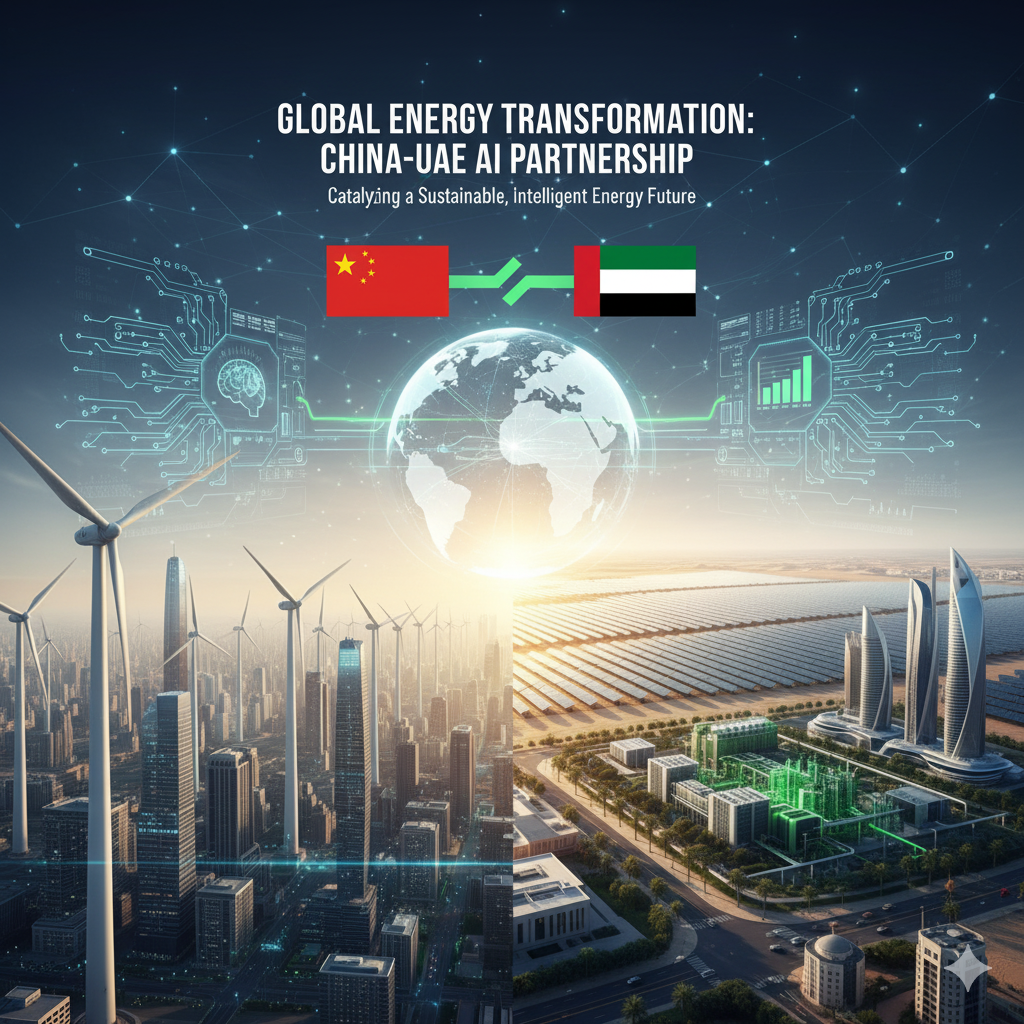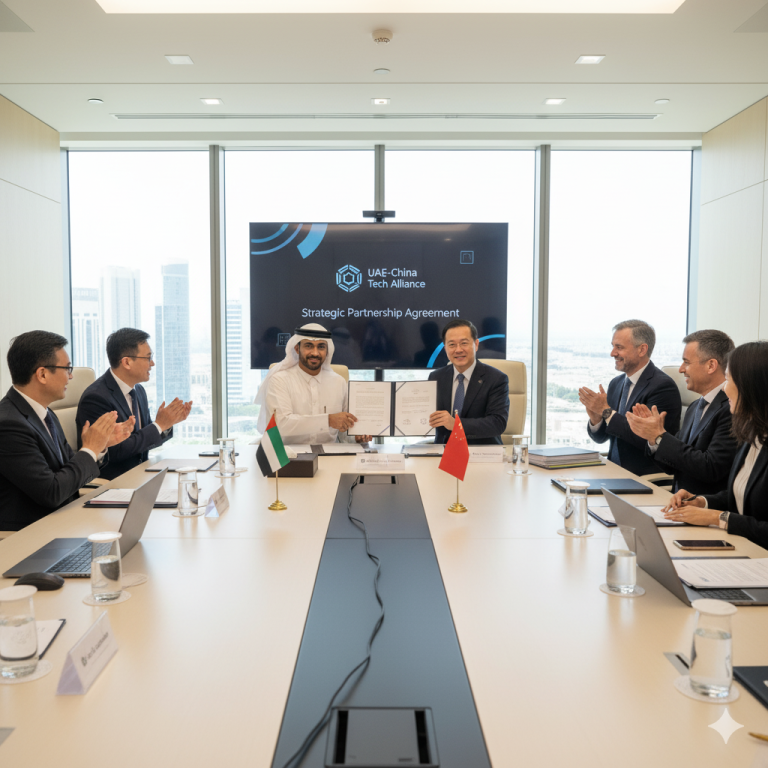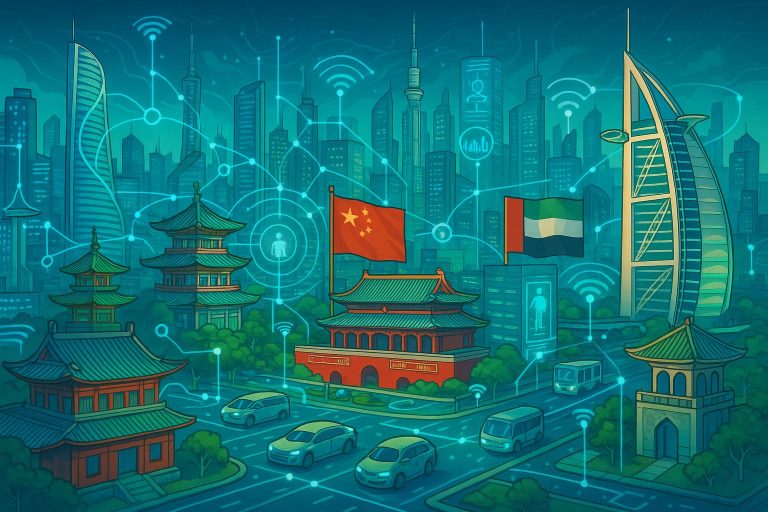Energizing the Future: AI’s Role in the China-UAE Renewable Energy Push
Introduction
The global energy landscape is undergoing a profound and irreversible transformation, driven by an urgent imperative to mitigate the escalating threats of climate change and to secure resilient, sustainable energy sources for future generations. This monumental shift from a fossil fuel-dominated era to one powered by renewable alternatives—such as solar, wind, and the burgeoning field of green hydrogen—is not merely an environmental dictate but also a powerful economic engine, fostering unprecedented innovation, creating new industries, and redefining geopolitical alliances worldwide. At the very core of this paradigm shift lies the catalytic power of advanced technology, particularly Artificial Intelligence (AI), which is rapidly proving to be an indispensable tool for optimizing every stage of energy production, enhancing the stability and intelligence of national grids, and dramatically improving overall energy efficiency across diverse sectors. As nations across the globe accelerate their efforts to embrace this green future, the strategic collaboration between key global players becomes not just beneficial, but absolutely paramount. This comprehensive report delves into the burgeoning and increasingly vital partnership between the People’s Republic of China and the United Arab Emirates (UAE) in the dynamic realm of AI-driven renewable energy. It meticulously examines how their combined strengths, complementary resources, and shared vision are propelling both nations, and indeed the broader international community, towards a more sustainable, technologically advanced, and economically robust energy future. The report will illuminate the profound strategic importance of this alliance, focusing on specific initiatives, significant investments, and the intricate technological synergies that collectively underscore its positive and far-reaching impact on the global green energy transition, painting a picture of innovation, cooperation, and shared prosperity. The narrative will explore the UAE’s ambitious clean energy strategy, China’s formidable leadership in green technology and AI, the practical applications of AI in optimizing renewable energy systems within the UAE, and the critical role of collaborations such as the Masdar-China connection. This analysis aims to provide a nuanced understanding of how this partnership is not only shaping the energy future of two influential nations but also contributing significantly to global efforts to combat climate change and foster sustainable development. The report will meticulously detail the strategic frameworks, key investments, and technological advancements that characterize this unique collaboration. Furthermore, it will highlight the potential for this bilateral cooperation to serve as a blueprint for other emerging economies seeking to balance rapid economic growth with environmental stewardship, showcasing a model of South-South cooperation in the critical domain of green technology, thereby amplifying its global resonance and impact and demonstrating a viable pathway towards a decarbonized global economy.
The UAE’s Clean Energy Strategy
The United Arab Emirates has, with remarkable foresight and strategic agility, emerged as a proactive and influential leader in the global clean energy transition. This leadership is underpinned by a steadfast national commitment to sustainability and a determined drive to diversify its economy away from its historical reliance on hydrocarbon resources. This strategic pivot is meticulously articulated and enshrined in ambitious national initiatives, most notably the UAE Energy Strategy 2050, a visionary roadmap that aims to elevate the contribution of clean energy in the total energy mix to an impressive 50% by the middle of the century, concurrently targeting a substantial 70% reduction in the carbon footprint of power generation [1]. To achieve these audacious goals, the nation has embarked on a program of heavy investment in large-scale renewable energy projects, with a particular emphasis on solar power. Flagship developments include the colossal Mohammed bin Rashid Al Maktoum Solar Park in Dubai, which is on track to become the largest single-site solar park globally, boasting a planned capacity of 5,000 MW by 2030. This project alone exemplifies the UAE’s commitment to not just adopting, but dominating, the solar energy landscape, showcasing its capacity for monumental infrastructure development.
Beyond the sun-drenched expanses of solar farms, the UAE is vigorously exploring and investing in other promising renewable energy avenues, including wind energy, and, most crucially, the transformative potential of green hydrogen. The development of green hydrogen, produced through the electrolysis of water powered exclusively by renewable electricity, is envisioned as a cornerstone of the UAE’s future energy exports and a critical component in the decarbonization of hard-to-abate industrial sectors. Multi-billion dollar green hydrogen facilities, such as those under development in Abu Dhabi, underscore the nation’s strategic foresight in positioning itself at the absolute forefront of this nascent yet profoundly transformative energy vector. These investments are not merely about energy production; they are about establishing a new global energy paradigm, securing a leadership position in the next generation of energy solutions.
Central to the UAE’s broader economic diversification and energy vision is the meticulously crafted UAE AI Strategy 2031. This comprehensive national framework is explicitly designed to cement the country’s position as a global leader in artificial intelligence. The strategy transcends mere technological adoption; it is about the deep and pervasive integration of AI across all vital sectors of the economy and society, with the ultimate aim of achieving the ambitious objectives of the UAE Centennial 2071 [2]. Critically, the strategy explicitly identifies renewable energy as a key sector ripe for AI integration, with specific goals to enhance facility management, optimize energy production processes, and significantly improve overall operational efficiency. By strategically leveraging AI, the UAE aims to achieve a multitude of societal benefits, from minimizing chronic diseases and reducing accidents in transport to enabling accurate experiments in space. However, its application in the energy sector is particularly revolutionary, as it seeks to fundamentally transform and optimize its renewable energy infrastructure [2]. The proactive formation of the UAE AI Council, complemented by a series of workshops, training programs, and collaborative initiatives for government bodies and private enterprises, signifies a concerted and holistic effort to cultivate a robust AI ecosystem. This ecosystem is meticulously designed to support and accelerate the nation’s clean energy ambitions, demonstrating a profound strategic alignment of AI development with sustainable growth and technological advancement. The UAE’s approach is thus a powerful testament to the belief that technological leadership and environmental stewardship are not mutually exclusive, but rather mutually reinforcing paths to national prosperity and global influence, setting a precedent for other nations to follow.
China’s Green Tech Leadership
China’s trajectory in the global renewable energy landscape is nothing short of remarkable, representing one of the most significant industrial transformations of the 21st century. Over the past two decades, the nation has meticulously engineered a pivot from being a substantial, and often criticized, consumer of fossil fuels to becoming an undisputed dominant force in green technology manufacturing, deployment, and innovation. Today, China not only leads the world in installed renewable energy capacity, particularly in the critical sectors of solar photovoltaics and wind power, but also stands as the preeminent global producer of electric vehicles, advanced batteries, and the essential components that underpin the entire clean energy value chain. This leadership is far from a mere matter of scale or industrial output; it is deeply and intrinsically intertwined with China’s strategic, top-down embrace of advanced technologies, most notably Artificial Intelligence, as a fundamental driver for enhancing efficiency, fostering innovation, and securing a competitive edge across its vast and complex energy sector.
China’s comprehensive approach to green technology is characterized by several key pillars: colossal, sustained investment in fundamental and applied research and development; rapid, state-backed industrialization; and aggressive, large-scale deployment strategies. This concerted effort has yielded profound results, leading to dramatic cost reductions in renewable energy components, which in turn has made solar panels, wind turbines, and associated technologies significantly more accessible and affordable on a global scale. This strategic advantage has allowed China to not only meet its own burgeoning energy demands but also to become the world’s leading exporter of green energy solutions. Furthermore, Chinese companies have consistently been at the vanguard of developing and implementing sophisticated AI-driven solutions tailored for comprehensive energy management, the creation of intelligent smart grids, and advanced predictive maintenance protocols. These AI applications are absolutely crucial for effectively integrating intermittent renewable sources, such as solar and wind, into the national grid without compromising stability. They are instrumental in optimizing energy distribution across vast geographical areas and significantly reducing waste throughout the energy supply chain. For instance, cutting-edge AI algorithms are now routinely employed to forecast renewable energy output with remarkable precision, dynamically manage demand-side response mechanisms, and substantially enhance the operational efficiency of both conventional power plants and complex transmission networks. This intelligent management is vital for maintaining grid balance and reliability in an increasingly renewable-heavy energy mix, ensuring a stable and secure energy supply for its massive population and industrial base.
The nation’s unwavering commitment to AI is formally articulated and institutionalized through ambitious national initiatives, such as the ‘New Generation Artificial Intelligence Development Plan.’ This plan explicitly aims to establish China as a global AI innovation center by 2030, recognizing AI’s profound and transformative potential across a myriad of industries, with the energy sector being a prime beneficiary. Chinese tech giants, frequently bolstered by substantial government subsidies and strategic backing, are actively engaged in the development and widespread deployment of AI solutions that are designed to enhance the reliability, sustainability, and overall performance of their energy infrastructure. This encompasses the development of sophisticated smart city solutions, which ingeniously integrate AI to optimize energy consumption patterns within dense urban environments, as well as advanced analytics platforms for the continuous monitoring and proactive maintenance of renewable energy assets. The powerful synergy between China’s formidable industrial might in green technology and its rapidly advancing AI capabilities unequivocally positions it as an indispensable and leading partner in the global transition towards a truly sustainable and intelligent energy future. This dual leadership ensures that China is not just a participant but a primary architect of the world’s green energy revolution, exporting its expertise and technology globally.
AI in Action: Optimizing Renewable Energy in the UAE
Artificial Intelligence is not merely a theoretical concept or a futuristic aspiration within the UAE’s clean energy strategy; it is a practical, actively deployed, and continuously evolving tool that is enhancing every facet of the renewable energy ecosystem. The strategic integration of AI is fundamentally transforming how energy is produced, meticulously distributed, and intelligently consumed, thereby driving unprecedented levels of efficiency, reliability, and sustainability across the entire nation. The UAE’s profound commitment to AI, as meticulously outlined in its visionary AI Strategy 2031, directly translates into tangible, impactful applications within the energy sector, firmly positioning the UAE as a global leader in AI investments across a diverse array of sectors, with renewable energy being a paramount focus [2].
One of the most critical and impactful primary applications of AI is in the optimization of energy production. In the sprawling expanses of solar parks, such as the monumental Mohammed bin Rashid Al Maktoum Solar Park, AI algorithms are not just monitoring; they are actively employed for sophisticated predictive maintenance. These algorithms meticulously analyze vast streams of data collected from thousands of individual solar panels, identifying subtle anomalies and potential faults long before they can escalate into significant operational disruptions or costly downtime. This proactive approach includes the innovative use of drones equipped with AI-powered thermal imaging cameras, which can swiftly detect hotspots, micro-cracks, or other performance-degrading issues, thereby ensuring maximum uptime, optimal energy yield, and prolonged asset lifespan. Furthermore, AI plays an absolutely crucial role in accurately forecasting the output of intermittent renewable sources like solar and wind energy. By synthesizing complex data sets encompassing real-time weather patterns, historical generation data, satellite imagery, and intricate sensor information, AI models can predict energy generation with remarkable precision. This predictive capability is invaluable for grid operators, enabling them to better balance supply and demand, manage grid stability, and integrate a higher penetration of renewables into the national grid more seamlessly and reliably. The precision offered by AI in forecasting allows for more efficient dispatch of conventional power sources, reducing fuel consumption and emissions, while also enabling better planning for energy storage solutions. This dynamic optimization ensures that the UAE’s renewable energy assets operate at their peak potential, maximizing return on investment and accelerating the transition away from fossil fuels, thereby solidifying the nation’s commitment to a sustainable future.
Smart grid management represents another transformative area where AI is making an indelible mark. The UAE is making substantial investments in cutting-edge smart grid technologies that leverage AI to intelligently monitor, precisely control, and continuously optimize the intricate flow of electricity from its point of generation all the way to its final consumption. AI-driven systems possess the capability to detect and isolate faults within the grid with unprecedented speed, automatically reroute power to prevent widespread outages, and manage peak loads far more effectively than traditional systems. This not only significantly enhances the reliability and resilience of the national grid but also crucially facilitates the seamless integration of distributed renewable energy sources, such as rooftop solar, and the rapidly expanding electric vehicle charging infrastructure. Collaborations with key Chinese partners, such as Huawei, have been instrumental in this domain. Huawei has been actively working with Dubai on developing advanced smart city solutions, which inherently incorporate sophisticated energy management systems that utilize AI to create more efficient, responsive, and sustainable urban energy networks [1]. These systems learn from consumption patterns, predict future needs, and dynamically adjust energy flows to minimize waste and maximize efficiency. The deployment of AI in smart grids also extends to demand-side management, where intelligent algorithms can incentivize consumers to shift energy usage to off-peak hours or respond to real-time pricing signals, further balancing the grid and reducing the need for costly infrastructure upgrades. This intelligent orchestration of energy flow is pivotal for creating a resilient and future-proof energy infrastructure capable of handling the complexities of a highly diversified energy mix, ensuring energy security and affordability.
Moreover, AI is proving to be an instrumental force in improving energy efficiency across a multitude of sectors within the UAE. In the built environment, AI-powered building management systems (BMS) are revolutionizing how commercial and residential properties consume energy. These intelligent systems analyze a dynamic array of factors, including occupancy patterns, real-time weather conditions, historical energy consumption data, and even individual user preferences, to precisely optimize heating, ventilation, and air conditioning (HVAC) systems, lighting, and other energy-intensive building functions. This granular optimization leads to substantial reductions in energy waste and operational costs. In industrial settings, AI is deployed for sophisticated process optimization, meticulously identifying inefficiencies in manufacturing lines, operational workflows, and supply chains that traditionally lead to excessive energy use. The UAE AI Strategy 2031 specifically targets renewable energy facility management, aiming to leverage AI to not only reduce operational costs but also to significantly enhance the overall performance and longevity of these critical assets [2]. This holistic and pervasive application of AI, spanning from the initial stages of energy generation through to its efficient consumption, unequivocally underscores the UAE’s strategic and forward-thinking vision to harness cutting-edge technology as the cornerstone for a truly sustainable and prosperous energy future. The continuous feedback loops and adaptive learning capabilities of AI systems ensure that the UAE’s energy infrastructure is not just efficient today, but is constantly improving and adapting to future challenges and opportunities. This includes the use of AI in optimizing water desalination plants, a major energy consumer in the UAE, by predicting maintenance needs and optimizing energy input, thereby reducing the energy footprint of a vital resource and contributing to water security.
The Masdar-China Connection
The collaboration between Masdar, Abu Dhabi’s globally recognized flagship renewable energy company, and various prominent Chinese energy firms stands as a powerful and tangible testament to the deepening, multifaceted partnership between the United Arab Emirates and China in the critical green energy sector. Masdar, a pioneering entity renowned for its leadership in sustainable urban development and its ambitious portfolio of renewable energy projects across the globe, has consistently and actively sought international partnerships to accelerate the pace of the global energy transition. In this strategic pursuit, China, with its unparalleled manufacturing capabilities, its vast technological prowess in renewable energy technologies, and its formidable financial resources, has unequivocally emerged as a crucial and indispensable ally.
While the provided research findings offer a broad overview of China-UAE AI cooperation, highlighting significant corporate partnerships with leading tech giants such as UBTECH Robotics, SenseTime Group, Huawei, and Alibaba Cloud [1], the underlying spirit and strategic imperative of this collaboration extend directly and profoundly into the renewable energy domain. Masdar’s engagement with Chinese entities is often characterized by a strategic leveraging of China’s advanced manufacturing capabilities for essential components like high-efficiency solar panels, state-of-the-art wind turbines, and advanced battery storage solutions. These components are then meticulously integrated and deployed in Masdar’s ambitious projects, both within the geographical confines of the UAE and across its expanding international footprint. This powerful synergy creates a mutually beneficial relationship: Masdar gains access to cost-effective, high-quality, and rapidly scalable components, which are vital for achieving its aggressive deployment targets, while Chinese firms, in turn, gain invaluable access to new, burgeoning markets and significant opportunities for the large-scale implementation of their cutting-edge technologies and project execution expertise. This extends to joint ventures in manufacturing and technology transfer, further solidifying the economic and technological ties. The collaboration also fosters a dynamic exchange of best practices and engineering know-how, accelerating the learning curve for both parties and pushing the boundaries of renewable energy innovation, thereby creating a virtuous cycle of advancement.
Beyond the transactional aspects of component supply, the collaboration extends significantly into the crucial realms of research and development, particularly in areas where AI can profoundly optimize renewable energy systems. Although specific, publicly detailed Masdar-China AI projects exclusively focused on renewable energy are not extensively enumerated in the immediate research findings, the broader context of the substantial $5 billion China-UAE partnership, which was strategically established in early 2025, unequivocally underscores a significant and deliberate focus on AI and technology, encompassing renewable energy and critical infrastructure development [3]. This overarching partnership involves G42, a leading UAE-based AI and cloud computing powerhouse, actively collaborating with Chinese tech giants on advanced machine learning applications, big data analytics, and the development of intelligent smart city solutions. Given Masdar’s central and pivotal role in spearheading the UAE’s clean energy strategy, it is not only probable but highly certain that these broader AI collaborations indirectly, and often directly, support and enhance Masdar’s diverse initiatives. This support is particularly evident in critical areas such as the development and implementation of sophisticated smart grid management systems, the application of predictive analytics for optimizing renewable asset performance and maintenance schedules, and the continuous refinement and optimization of green hydrogen production processes, ensuring maximum efficiency and cost-effectiveness. The exchange of expertise and joint research initiatives in these areas are paving the way for next-generation renewable energy solutions. This deep integration of AI into renewable energy projects, facilitated by the Masdar-China connection, is creating a robust framework for innovation that will drive the next wave of advancements in sustainable energy technologies, ensuring both nations remain at the forefront of the global energy transition.
The strategic alignment between China’s ambitious Belt and Road Initiative (BRI) and Abu Dhabi’s expansive development plans further solidifies and deepens this intricate connection. This alignment creates a robust framework for joint infrastructure development that almost invariably includes significant renewable energy components, reflecting a shared vision for sustainable growth and connectivity [3]. Furthermore, high-level diplomatic and economic engagements, such as the Investopia Beijing Forum held in September 2025, which specifically focused on enhancing economic partnerships in the new economy, AI, and green technology, serve as powerful indicators of the ongoing, unwavering commitment to strengthen these vital ties [4]. This robust and evolving Masdar-China connection, therefore, represents far more than a mere commercial arrangement; it embodies a powerful and strategic alliance that masterfully combines capital, cutting-edge technology, and a shared strategic vision to drive significant, transformative advancements in the global renewable energy landscape. It is a partnership poised to redefine the future of sustainable energy on a global scale, demonstrating the immense potential of international cooperation in addressing complex global challenges, and ultimately contributing to a more stable and prosperous world order.
Conclusion
The partnership between China and the United Arab Emirates in the realm of AI-driven renewable energy represents a powerful and increasingly vital force in the global green energy transition. This collaboration is built upon a foundation of mutual strategic interests: the UAE’s ambitious vision to diversify its economy and become a global leader in clean energy, and China’s unparalleled technological prowess and manufacturing dominance in the renewable energy sector, coupled with its advanced AI capabilities. As demonstrated throughout this report, AI is not merely an ancillary tool but a central enabler, optimizing energy production, enhancing grid stability, and improving overall energy efficiency across the UAE’s burgeoning renewable energy infrastructure.
From high-level forums and agreements to significant corporate and educational partnerships, the ties between China and the UAE in AI and green technology are deepening. The UAE’s commitment, exemplified by its AI Strategy 2031, strategically aligns AI development with its clean energy goals, ensuring that cutting-edge technology is harnessed to achieve sustainable growth. Concurrently, China’s leadership in green tech, underpinned by its AI-driven solutions for energy management, provides an indispensable resource for the UAE’s aspirations. The active involvement of Chinese tech giants like Huawei and Alibaba Cloud in the UAE’s digital transformation, alongside the strategic collaborations between entities like Masdar and Chinese firms, underscores a synergistic relationship that benefits both nations.
Despite geopolitical complexities and external pressures, the strategic importance of this partnership remains undeniable. As the UAE navigates the global technological landscape, China often emerges as a crucial partner, offering advanced AI capabilities and significant financial support that revitalizes the UAE’s innovation ecosystem. The $5 billion China-UAE partnership, focusing on AI, renewable energy, and infrastructure, further solidifies this bond, promising to create thousands of jobs and attract substantial foreign investment [3]. This collaboration also serves as a critical counterpoint to the narrative of technological decoupling, demonstrating how strategic alliances can be forged even amidst broader geopolitical currents, driven by shared economic and environmental imperatives. The long-term vision embedded in these partnerships extends beyond mere economic gains, aiming to foster a sustainable future for both nations and contribute significantly to global climate action, thereby enhancing global energy security and environmental stewardship.
In essence, the China-UAE partnership is more than just a bilateral agreement; it is a dynamic alliance that combines capital, technology, and strategic vision to accelerate the global shift towards a sustainable energy future. By leveraging AI to enhance the efficiency and effectiveness of renewable energy systems, both nations are not only securing their own energy futures but also setting a compelling example for international cooperation in addressing one of humanity’s most pressing challenges. This collaboration is a key driver, demonstrating how strategic alliances can indeed energize the future, paving the way for a greener, more intelligent, and sustainable world. The positive tone of this report reflects the optimistic outlook on this collaboration, highlighting its potential to serve as a model for other nations seeking to combine technological advancement with environmental stewardship. The continuous evolution of AI technologies, coupled with the increasing urgency of climate action, suggests that the China-UAE partnership will only grow in significance, contributing profoundly to the global energy transition and fostering a new era of international cooperation in sustainable development. This strategic alignment underscores a shared commitment to innovation, economic diversification, and environmental responsibility, positioning both China and the UAE as pivotal players in shaping the future of global energy. Their joint efforts in harnessing AI for renewable energy are not just about megawatts and algorithms; they are about building a more resilient, prosperous, and environmentally conscious world for generations to come, creating a legacy of sustainable progress and international collaboration that will undoubtedly inspire similar initiatives globally. This profound partnership stands as a beacon of hope, demonstrating that with strategic vision, technological innovation, and unwavering commitment, a sustainable energy future is not only achievable but within reach for all nations.







